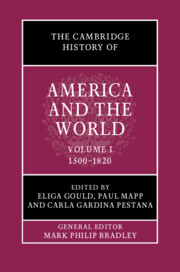Book contents
- The Cambridge History of America and the World
- The Cambridge History of America and the World
- The Cambridge History of America and the World
- Copyright page
- Contents
- Figures
- Maps
- Contributors to Volume I
- General Introduction: What is America and the World?
- Introduction: What Does America and the World “Mean” before 1825?
- Part I Geographies
- Part II People
- Part III Empires
- Part IV Circulation/Connections
- Part V Institutions
- Part VI Revolutions
- Index
Introduction: What Does America and the World “Mean” before 1825?
Published online by Cambridge University Press: 12 November 2021
- The Cambridge History of America and the World
- The Cambridge History of America and the World
- The Cambridge History of America and the World
- Copyright page
- Contents
- Figures
- Maps
- Contributors to Volume I
- General Introduction: What is America and the World?
- Introduction: What Does America and the World “Mean” before 1825?
- Part I Geographies
- Part II People
- Part III Empires
- Part IV Circulation/Connections
- Part V Institutions
- Part VI Revolutions
- Index
Summary
Studying “America and the World” in the period before the advent of the United States carries a different meaning than it does after 1776. As used by historians of the modern United States, as in the other volumes in this series, America and the world usually refers to the foreign policy and global interactions of the American republic, with the United States occupying the role of an independent power and, increasingly, an empire. This volume calls for a different agenda: to understand how the United States emerged out of a series of colonial interactions, some involving Indigenous empires and communities that were already present when the first Europeans reached the Americas; others the adventurers and settlers dispatched by Europe’s imperial powers to secure their American claims; and still others men and women brought as slaves or indentured servants to the colonies that European settlers founded. For most of the 300 years after the first European voyages of discovery, we use America to refer not to a single political entity, much less an empire, but rather to a space within which other states, peoples, and empires, many of them centered outside the Western Hemisphere, interacted and vied for supremacy and control.
- Type
- Chapter
- Information
- The Cambridge History of America and the World , pp. 8 - 34Publisher: Cambridge University PressPrint publication year: 2022

